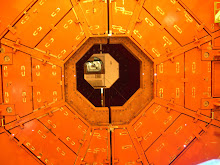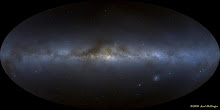 Yesterday, a group of LHC critics filed a suit against CERN in the European Court of Human Rights, in Strasbourg . The authors of the suit are physicists, professors and students largely from Germany and Austria, who feel that the operation of the $10 billion Large Hadron Collider near Geneva, poses grave risks for the safety and well-being of the 27 member states of the European Union and their citizens. The Rule of Law, the suit states, is also threatened. The legal arguments that define the legitimacy of the suit appear clear-cut, and have been crafted in German by a well known Professor of International Law, Adrian Hollaender.
Yesterday, a group of LHC critics filed a suit against CERN in the European Court of Human Rights, in Strasbourg . The authors of the suit are physicists, professors and students largely from Germany and Austria, who feel that the operation of the $10 billion Large Hadron Collider near Geneva, poses grave risks for the safety and well-being of the 27 member states of the European Union and their citizens. The Rule of Law, the suit states, is also threatened. The legal arguments that define the legitimacy of the suit appear clear-cut, and have been crafted in German by a well known Professor of International Law, Adrian Hollaender.The arguments for several major risks that might develop into wholesale disasters are based on papers from various physicists and a risk assessment analyst, whose conclusions will be examined by the court as well as counter-arguments by CERN. It's a question of theories versus theories. The outcome is anyone's guess, but a cogent risk analysis could be the deciding factor. The suit highlights the possible production of Micro Black Holes, which could be a pollution hazard or combine and destroy the LHC. In the worst case, mBH could start consuming the planet, producing dangerous radiation.
MBH are admitted as theoretically possible by CERN. Indeed CERN anticipated large scale production of mBH, but lately has refuted the possibility and denied that they could be produced at the LHC, unless there were extra dimensions as postulated in String Theory. In that case CERN says mBH would be harmless, evaporating quickly due to a theoretical Hawking radiation, though this radiation has not been detected from black holes in space.
Bosenovas are a new risk theory in the suit, besides the better known Strangelets and Lowered Vacuum State theories. Unlike the others there is some experimental evidence for a Bosenova, but this phenomenon of implosion/explosion has only been produced in small groups of atoms of Rubidium-85 in an ultracold state, a Bose-Einstein Condensate.
What might occur at the LHC, is a new type of Bosenova from what amounts to a BEC used there as a coolant, an ultracold Superfluid Helium II, of about 60 metric tonnes in the LHC ring, and a further 60 tonnes of somewhat warmer Superfluid Helium I in refrigeration plants on the surface connected to the subterranean main ring. Whether possible or not is unknown, no experiments having been done by CERN to rule out the possibility, nor any theoretical model studies. The Bosenova risk was first raised in an article by Alan Gillis in the on-line science magazine, ScientificBlogging, July 2, 2008, "Superfluids, BECs and Bosenovas: The Ultimate Experiment".
The first full proton beam injection into the LHC is due September 10th. As further studies and experiments required to assess risks are a long way off, and even a decision on risks as presented by the plaintiffs could take the European Court some time to evaluate, the authors of the suit are asking the court for a speedy granting of Interim Measures. The LHC should be shut-down pending the Court's ruling. The argument that the LHC be limited to no more than 2 TeV energy overall, similar to Fermilab's Tevatron collider design energies, they exclude from the Court's consideration.
A similar suit is before the US court in Hawaii, launched by Dr Walter Wagner and Dr Luis Sancho, against CERN and Fermilab, court in session September 2nd.


























2 comments:
Update on Euro Court Action: After appearing here first and now in my column on ScientificBlogging, http://www.scientificblogging.com/alan_gillis -- this news story broke in the major media yesterday in the Tribune de Genève, the article Plainte contre le CERN à la Cour européenne des doits de l'homme.
Today a Swiss news service, SwissInfoCh, reported on the first deliberations at the ECHR, the headline "Court rejects protest against Big Bang machine" The suit though is still alive. The short article states, "The court is still to decide on allegations that the experiment with the Large Hadron Collider (LHC) violates the right to life."
Some important news relevant to this Court action was posted as a Comment on this same story on ScientificBlogging by JTankers, who notes that a new chromium-52 BEC was produced at the University of Stuttgart, published in PhysicsWorld August 27th, http://physicsworld.com/cws/subject/condmat;jsessionid=4375893BEA389F2DF73314CD44404D28 “Cold atoms explode like cloverleafs”.
CERN and the LSAG, not having produced any studies or experiments on Helium BEC Bosenovas, will now have to take Bosenovas seriously, as this new Bosenova suggests others are possible, and CERN’s LHC uses 120T of Superfluid Helium, about half is Helium I and so 60T of Superfluid Helium II BEC in the subterranean 27 km collider ring as a coolant.
A big enough Bosenova if produced could likely destroy the LHC. Part of the suit in the ECHR considers Bosenova risks at the LHC.
More on the ECHR lawsuit.
I got an email response from one of the people behind the legal action against CERN in Europe, Markus Goritschnig. I'd sent a friendly email to Dr Walter Wagner, CC'd to Markus and Dr Otto Rössler, on how the speedy decision of the ECHR, favoring CERN, except on the continuing "Right to life" challenge, might be read and affect both suits, especially Dr Wagner's also still in progress.
From what I gather about these legal proceedings, the plaintifs are fighting the LHC with theoretical arguments about the existance of objects that might be produced and how dangerous they might be if produced, like mBH, Strangelets and other things no one has ever seen.
I emailed my observations on these lawsuits to those most concerned, privately, though I don't mind that they are public now.
Markus happily extracted some of my comments unknown to me and published them on his organization's German website, LHC Kritik, in a comment in English, http://www.lhc-concern.info/
It's no secret that I don't support going ahead full blast with a giant collider, that could blow itself up and Geneva, all theoretical arguments aside.
After all it is first and foremost the biggest machine on the planet, using collosal energies never used before. In this lawsuit the LHC is described as using the energy of half a nuclear power plant, indeed as much electricity as greater Geneva consumes. It's brand new and unprecidented. It's not a new car or a new toy. It's 17 miles of main tunnels packed with new technology and old, about 50,000T, not including the 6 Detectors, which would fill Notre Dame Cathedral and a half of St Denis in Paris, including more iron than in the Eiffel Tower.
Is it safe? The debate goes on. Switching it on at 5 TeV to find out, is a gamble.
Check out their website for more debate and information. The media in Europe are now on the alert, and some journalists are writing in Comments there.
If you want to easily translate the rest of this website into English, use Google Search and click Translate, before going to the website. It's a fair guide to what's on there.
The quotes I used that Markus borrowed are from Nikolai Mokov of Fermilab, now with CERN, from an article published December 2007 by Symmetry Magazine, a joint endeavor of Fermilab/SLAC, "Protecting the LHC from itself", http://www.symmetrymagazine.org/cms/?pid=1000570
Post a Comment